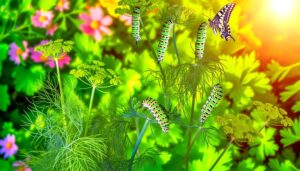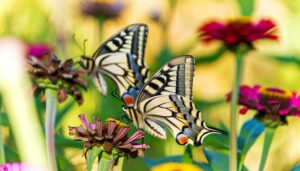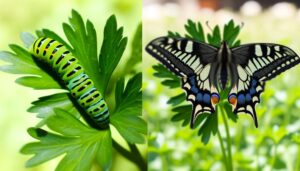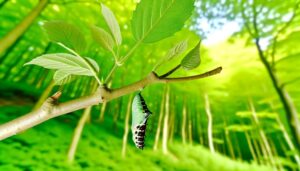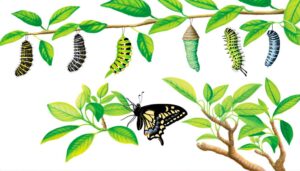Eastern Black Swallowtail Butterfly Caterpillar: Guide!
The Eastern Black Swallowtail butterfly caterpillar (Papilio polyxenes) is notable for its vibrant green body adorned with black bands and yellow-orange spots.
It thrives in North America, inhabiting fields, gardens, and wetlands, and prefers Apiaceae plants like dill, parsley, and fennel. The caterpillar employs remarkable defense mechanisms, such as cryptic coloration and a foul-smelling osmeterium, to evade predators.
Remarkably, its life cycle includes camouflaging as bird droppings during early larval stages. For those curious about its detailed behavior and contributions to ecosystems, this caterpillar offers a wealth of intriguing aspects.
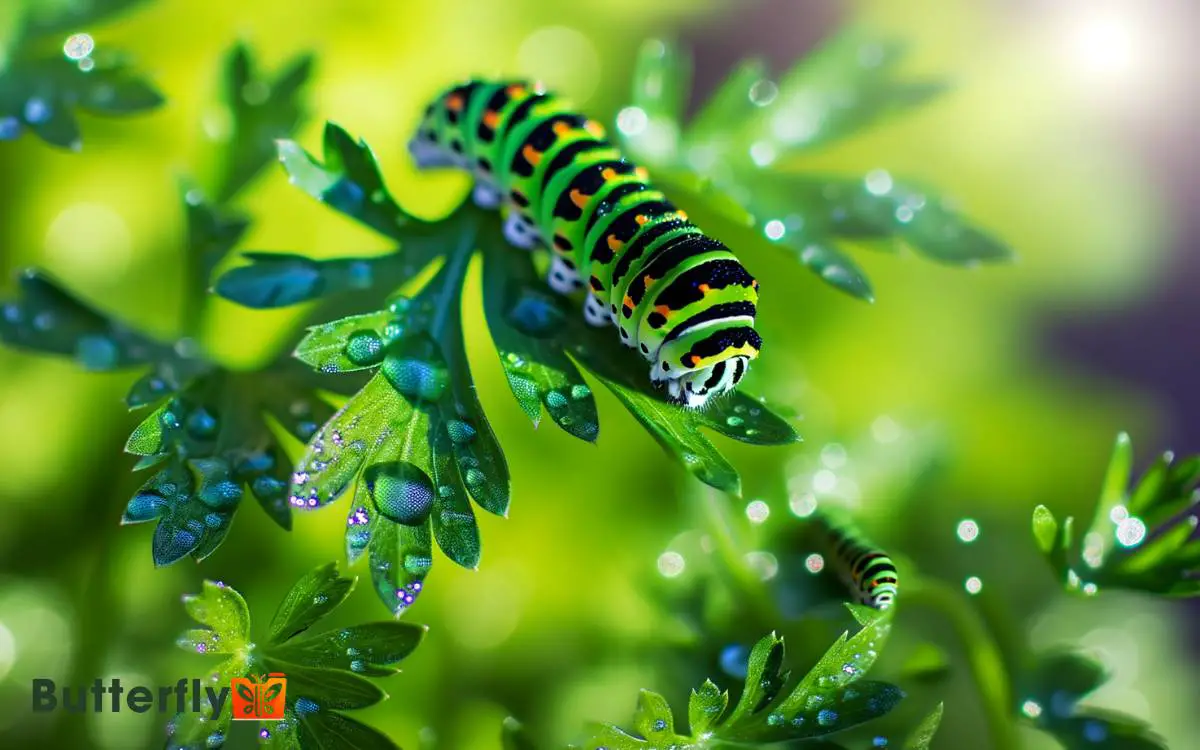
Key Takeaways
Identification and Appearance
The Eastern Black Swallowtail butterfly caterpillar, scientifically known as Papilio polyxenes, displays distinctive coloration and markings that aid in its identification.
In its early instars, the larva exhibits a black body adorned with a white saddle-like band and spiny protrusions, resembling bird droppings a clever camouflage against predators.
As it matures, the caterpillar transforms into a vibrant green organism with symmetrical black bands, each punctuated by yellow or orange spots. The segments are smooth, devoid of spines, providing a sleek appearance.
Importantly, it possesses an osmeterium, an orange, forked gland behind its head, which it can evert when threatened, releasing a foul odor to deter predators. These distinctive features mark Papilio polyxenes as a marvel of evolutionary adaptation.
Habitat and Distribution
Found primarily in North America, the Eastern Black Swallowtail butterfly caterpillar thrives in diverse habitats ranging from open fields to gardens and wetlands. These caterpillars are often spotted feeding on plants such as parsley, dill, and fennel, which serve as their primary host plants. As they grow, they undergo several molts, transforming from spiky black-and-white larvae into smooth green caterpillars with striking yellow and black markings. Due to their unique appearance and role in pollinator conservation, many enthusiasts seek swallowtail butterfly caterpillars for sale to raise and release them into their local environment.
Known scientifically as Papilio polyxenes, this species is widely distributed across the eastern United States and parts of southern Canada. It prefers areas rich in Apiaceae plants, such as dill, parsley, and fennel, which serve as both food sources and oviposition sites.
Observations indicate that these caterpillars are adaptable, inhabiting both rural and urban environments. They’re often found at elevations up to 1,500 meters.
This adaptability provides a broad range for the species, allowing it to colonize various ecological niches while maintaining genetic diversity. Researchers note that land management practices can have a significant impact on their distribution.
Life Cycle Stages
Eastern Black Swallowtail butterfly caterpillars undergo a complete metamorphosis, progressing through distinct life cycle stages including egg, larva, pupa, and adult. Belonging to the family Papilionidae, these butterflies exhibit remarkable transformations.
- Egg: Females lay tiny, spherical eggs on host plants.
- Larva: Hatchlings are initially black with white bands, resembling bird droppings for camouflage.
- Pupa: The caterpillar forms a chrysalis, a protective casing, where it undergoes transformation.
- Adult: Emerging as a striking butterfly with black wings adorned with yellow spots.
- Reproduction: Adults engage in mating, initiating the cycle anew.
This cycle not only secures species survival but also showcases nature’s intricate design, inviting observers to marvel at each stage’s uniqueness.
Diet and Feeding Habits
Understanding the dietary preferences of the Eastern Black Swallowtail butterfly caterpillar is vital for appreciating its ecological role and survival strategies.
Papilio polyxenes, commonly known as the Eastern Black Swallowtail, primarily feeds on plants in the Apiaceae family. Their preferred hosts include dill (Anethum graveolens), parsley (Petroselinum crispum), and fennel (Foeniculum vulgare).
These caterpillars exhibit selective feeding behavior, consuming tender leaves and stems to maximize nutrient intake. This herbivorous diet supplies essential compounds such as furanocoumarins, aiding in the caterpillar’s growth and development.
Observations indicate that larvae adapt their feeding patterns based on plant availability and environmental conditions, showcasing remarkable flexibility.
Feeding intensively during the larval stages, they secure sufficient energy reserves for upcoming metamorphosis.
Predators and Defense Mechanisms
The Eastern Black Swallowtail butterfly caterpillar, Papilio polyxenes, employs a variety of defense mechanisms to deter predators, ranging from cryptic coloration to the deployment of specialized structures like the osmeterium.
This species is subject to predation by birds, wasps, and other insectivores.
To enhance its survival, the caterpillar utilizes:
- Cryptic coloration: Green and black bands help it blend into host plants.
- Osmeterium: Eversible, glandular organ that emits foul-smelling chemicals.
- Behavioral adaptations: Quick retraction into foliage when threatened.
- Mimicry: Resembling bird droppings in early instars to avoid detection.
- Chemical defenses: Sequestration of toxic compounds from host plants.
These strategies collectively decrease predation risk, ensuring the caterpillar’s progression to the pupal stage.
Role in the Ecosystem
Beyond their defense mechanisms, Papilio polyxenes caterpillars play a significant role in their ecosystem by serving as both herbivores and prey, influencing plant dynamics and supporting higher trophic levels.
As herbivores, these larvae primarily consume Apiaceae family plants, specifically parsley, dill, and carrot. Their feeding habits can regulate plant population and health, demonstrating intricate plant-herbivore interactions.
Concurrently, they provide essential nutrition for various predators, including birds, spiders, and predatory insects, thereby sustaining the food web.
In their larval stage, the caterpillars’ presence influences biodiversity, promoting ecological balance. Through their role as prey, they bolster predator populations, which in turn control other pest species.
This dual role underscores their critical contribution to maintaining a dynamic and balanced ecosystem.
Conclusion
To sum up, the Eastern Black Swallowtail caterpillar (Papilio polyxenes) embodies the marvels of metamorphosis. Its life stages egg, larva, pupa, and adult illustrate nature’s intricate dance.
Thriving in diverse habitats, this caterpillar’s diet primarily includes Apiaceae plants, revealing an ecological niche. Predators abound, yet its striking coloration and osmeterium provide defense.
Truly, the Eastern Black Swallowtail isn’t just a species; it’s a reflection of biodiversity’s resilience. Nature’s narrative, painted in vivid hues, continues to captivate and inspire.

